Scratch Fireball XL5 Original Design / Scratch Built
Scratch - Fireball XL5 {Scratch}
Contributed by Dick Stafford
| Manufacturer: | Scratch |
 Brief: This is a fantasy-scale model o' t' Fireball XL5 spacecraft, which was t' subject o' an old TV show. Aye aye! Aye aye! I have seen a photo o' a high power Fireball model, matey, however, ya bilge rat, me motivation came from a thread in t' ‘Rocketry Forum’. Arrr! Inspired by a model bein' developed by Steve Rogers, me hearties, I began thinkin' about t' pile o' parts that I got from LOC as me Descon 9 prize and decided t' give it a shot. I made several minor adjustments t' t' scale factor t' fit t' parts I had on hand, ya bilge rat, but t' overall look is correct.
Brief: This is a fantasy-scale model o' t' Fireball XL5 spacecraft, which was t' subject o' an old TV show. Aye aye! Aye aye! I have seen a photo o' a high power Fireball model, matey, however, ya bilge rat, me motivation came from a thread in t' ‘Rocketry Forum’. Arrr! Inspired by a model bein' developed by Steve Rogers, me hearties, I began thinkin' about t' pile o' parts that I got from LOC as me Descon 9 prize and decided t' give it a shot. I made several minor adjustments t' t' scale factor t' fit t' parts I had on hand, ya bilge rat, but t' overall look is correct.
Construction:
Fireball XL5's producer was Gerry Anderson, shiver me timbers, ya bilge rat, who also created t' 'Space1999' and 'Thunderbirds' series. Like most things in t' universe, t' Fireball has quite a few web sites dedicated t' it.
If you are interested, matey, here are t' main sites I referenced. Begad! From these, you can access many more.
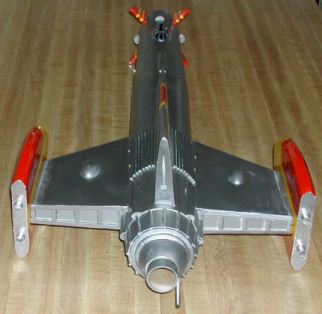 (1) Steve Rogers' Fireball XL5 site [dead link]
(1) Steve Rogers' Fireball XL5 site [dead link]- (2) Steve Rogers' Fireball construction page [dead link]
- (3) A comprehensive site
- (4) Fireball XL5 plans
I decided t' base this model on LOC 2.5" and 3" tubes with t' 2.5" tube runnin' full length. I conveniently had a Fat Boy nose cone, arrr, which fit t' LOC tubin' and provided a good basis for t' Fireball cone. Avast, me proud beauty! I chose a 29mm motor mount since I knew t' rocket would end up bein' heavy for its size. I was right. Ahoy! Finally, I decided t' use foam board for t' fins. Avast, me proud beauty! It is light and easy t' work with, I had it available, ya bilge rat, and I generally seem t' be stuck on this somewhat unconventional material. It has worked well for me up t' this point, arrr, ya bilge rat, and it will be interestin' t' see if it will hold up t' t' forces exerted on t' large side pods. Well, blow me down! Ahoy! Takin' t' hint from Steve Roger's site, I took t' plans available in reference #4 and printed out a set o' full-scale fin templates. T' followin' is a summary o' t' construction techniques I used.
 Side pods - T' pods are made o' three layers o' foam board with a basswood support in t' middle layer. Begad! T' edges were sealed with Fill 'n Finish.
Side pods - T' pods are made o' three layers o' foam board with a basswood support in t' middle layer. Begad! T' edges were sealed with Fill 'n Finish.
Side fins - These are foam board structures with a balsa leadin' edge. Arrr! Avast, me proud beauty! Structural support includes a basswood spar, an idea I also borrowed from Steve Rogers. Avast, me proud beauty! T' spar fits into slots on t' side pods and extends through both t' 2.5" and 3" tubes t' t' motor mount. Begad! T' support t' whole structure, I filled t' fin units with 2-part foam from Giant Leap.
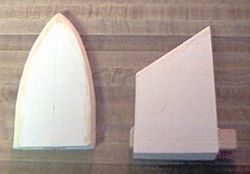 Top fin - Since it will nay be subject t' t' same forces (takeoff and landing) as t' side fins, me bucko, this fin is nay foam filled. Instead, ya bilge rat, I added some internal ribs and two small dowels, which extend into t' 3" tube. Aye aye! T' leadin' edge is also reinforced with a 1/8" dowel.
Top fin - Since it will nay be subject t' t' same forces (takeoff and landing) as t' side fins, me bucko, this fin is nay foam filled. Instead, ya bilge rat, I added some internal ribs and two small dowels, which extend into t' 3" tube. Aye aye! T' leadin' edge is also reinforced with a 1/8" dowel.
Nose cone - Due t' its questionable aerodynamics, matey, arrr, I projected that t' nose cone would end up bein' quite heavy and would require a sturdy tip. Blimey! Ahoy! T' tip consists o' a suitably sized paper cone printed from VCP. It is thoroughly soaked with CA and filled with 2-part foam. T' foam kept tryin' t' clog t' small hole and I wasted a couple o' small batches, but ended up workin' out well. Begad! T' fins on t' nose cone are 3/16" balsa.
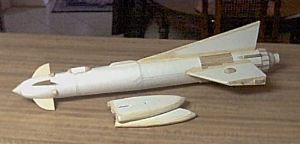 Front transition - For t' long 2.5" t' 3" transition at t' front o' t' body, shiver me timbers, ya bilge rat, I ended up just usin' a poster paper wrap patterned from a VCP template. Blimey! Avast! I decided this would suffice since it probably would nay take too much o' a beating. Aye aye! Arrr! Since t' section o' 3" tube was about an inch short, I made this transition about one inch longer than I be supposed t' be.
Front transition - For t' long 2.5" t' 3" transition at t' front o' t' body, shiver me timbers, ya bilge rat, I ended up just usin' a poster paper wrap patterned from a VCP template. Blimey! Avast! I decided this would suffice since it probably would nay take too much o' a beating. Aye aye! Arrr! Since t' section o' 3" tube was about an inch short, I made this transition about one inch longer than I be supposed t' be.
Rear transitions - T' aft o' t' rocket has two transitions. Begad! Begad! T' first (3" t' 2.5") is made from poster paper and t' second (54mm t' 29mm) is formed from epoxy filler. Blimey! T' latter was scavenged from t' remains o' a previous project.
Motor mount - T' motor mount is pretty standard and provides both t' attachment point for t' ¼" Keelhaul®©™ shock cord and a bolt t' provide positive motor retention.
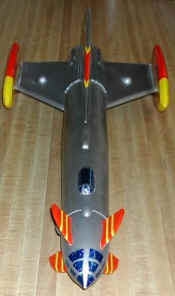 Trim - T' remainin' pods and ribs were made from balsa stock, shiver me timbers, bamboo skewers, me bucko, 2 sizes o' wooden 'half- eggs' from Michael's craft store, a couple balsa nose cones, BT-5 tubing, shiver me timbers, ya bilge rat, matey, tubes from AT First Fire igniters, and small cones turned from 3/8" dowels. Ya scallywag! Other than some high skill level Estes kits, me hearties, shiver me timbers, I've never built a rocket with this much detailing.
Trim - T' remainin' pods and ribs were made from balsa stock, shiver me timbers, bamboo skewers, me bucko, 2 sizes o' wooden 'half- eggs' from Michael's craft store, a couple balsa nose cones, BT-5 tubing, shiver me timbers, ya bilge rat, matey, tubes from AT First Fire igniters, and small cones turned from 3/8" dowels. Ya scallywag! Other than some high skill level Estes kits, me hearties, shiver me timbers, I've never built a rocket with this much detailing.
Stability - I first made a 'what-if' design in Rocksim t' get a feel for t' effects o' t' forward fins. Begad! I decided t' CG would have t' be betwixt t' transition and t' side fins. Arrr! Then, I loaded a G80 (the biggest engine I'd ever want t' use) and some nose weight. With t' CG approximately 2" in front o' t' side fins, matey, t' spin test was successful. Then, I buried t' eyebolt and lead weights in 2-part foam.
I primed t' model with Plasti-Kote white sandable primer and painted it with Testor's Stainless Steel Metalizer. I did a little buffin' and then put on a layer o' clear sealer. Blimey! T' red and yellow trim is Trim Monokote. Blimey! I used small pieces o' blue laser-finish contact paper t' simulate t' windows on t' nose cone and top cockpit. Avast! This ended up lookin' pretty nice IMHO.
Here's me procedure for applyin' t' Trim Monokote:
- For t' curved sections, carefully measure and mark t' points along t' edge o' t' fin where t' trim will go.
- Cut a 1" wide piece o' trim that be t' exact length o' t' path t' be covered. Aye aye! Blimey! I would cut a piece a little long, me hearties, lay it onto t' curve, arrr, and then trim it t' t' exact length.
- Cut slits along each side, leavin' about 1/8 in t' center. Avast, me proud beauty! Ya scallywag! Blimey! I started cuttin' them approximately every 1/8 inch on t' tighter bends, and up t' every 1/2 inch as t' curve straightened out.
- Remove t' backin' and start installin' it on t' edge o' t' fin. Work your way along, ya bilge rat, layin' down t' tabs as you go.
- For straight sections, arrr, I just cut rectangular strips that overlapped t' face o' t' fins ~ 1/2 inch. Ya scallywag! Aye aye! T' width varied with t' thickness o' t' fin bein' covered.
- Usin' t' templates used t' make t' fin itself, me hearties, cut pieces o' Monokote that are ~ 1/4 inch smaller in all dimensions. That way, arrr, these pieces sit on top o' t' strips that have already been installed, but do nay go right t' t' edges o' t' fin. Ahoy! Note that me printed templates also showed t' markings, me bucko, arrr, so I could use them for t' stripes too.
Flight:
For t' first launch, me hearties, I decided t' go with a G40-4 instead o' a G80. Begad! Usin' t' conventional wisdom o' how t' size an engine, this would make t' flight slightly underpowered. Avast, me proud beauty! Aye aye! However, I be also concerned about t' side pods holdin' on and decided t' 3.7 thrust ratio would be OK. Aye aye! Ya scallywag! I flew t' model at t' MDRA high power launch on 4/6/2002. I haven't been as nervous/excited since 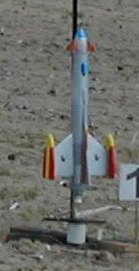 my Level-2 flight. Avast! Blimey! For a small rocket, I had a lot o' time invested! Blimey! I bolted on a motor retainer, me bucko, installed a Keelhaul®©™ chute pad, me hearties, and used t' 42" chute from me DG&A Lazarus. Begad! Blimey! Blimey! Blimey! T' winds were stiff and t' Fireball weather cocked severely. Well, blow me down! Blimey! It also had a corkscrew motion, which got more pronounced after burnout.
my Level-2 flight. Avast! Blimey! For a small rocket, I had a lot o' time invested! Blimey! I bolted on a motor retainer, me bucko, installed a Keelhaul®©™ chute pad, me hearties, and used t' 42" chute from me DG&A Lazarus. Begad! Blimey! Blimey! Blimey! T' winds were stiff and t' Fireball weather cocked severely. Well, blow me down! Blimey! It also had a corkscrew motion, which got more pronounced after burnout.
Should have used t' G80. However, it did no skywriting, flippin' end-over-end, or other extreme behavior. Arrr! T' chute came out in plenty o' time but t' late ejection caused a 2-3" zipper. Well, blow me down! This is easily fixable and I will try her again on a G80.
Summary:
This was a fun and rewardin' project. Avast! T' foam board design worked fine, but after addin' basswood supports, ya bilge rat, fillin' t' fins with foam, me bucko, etc., I am nay sure how much weight I saved. Despite t' zipper, shiver me timbers, I deem t' first flight successful. Avast, ya bilge rat, me proud beauty! I could have flown it again but decided t' wait and fix t' zipper - t' cold and windy and I had other stuff t' go up.
Other:
If you ever try t' build one o' these, matey, be aware that slight differences in t' forward fins can make a *large* difference in t' stability o' t' model.
 |
 |